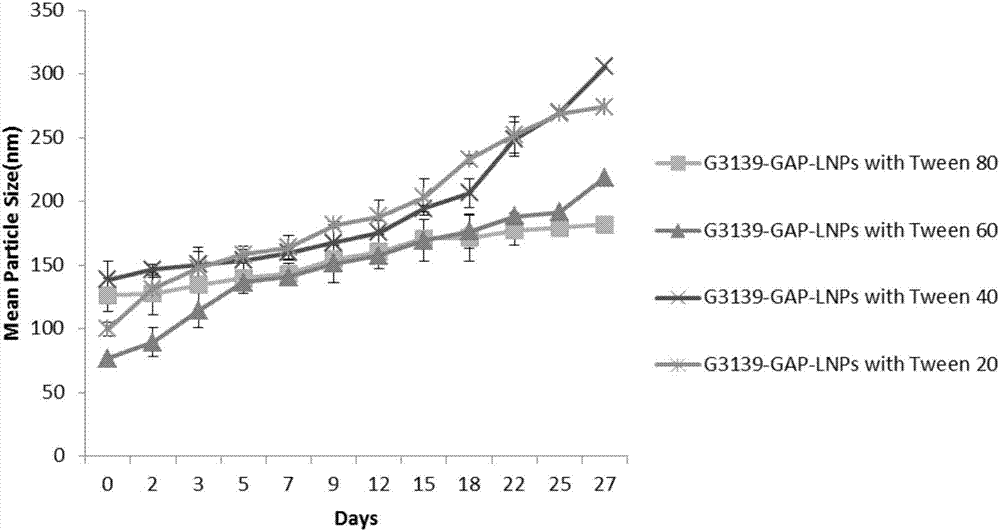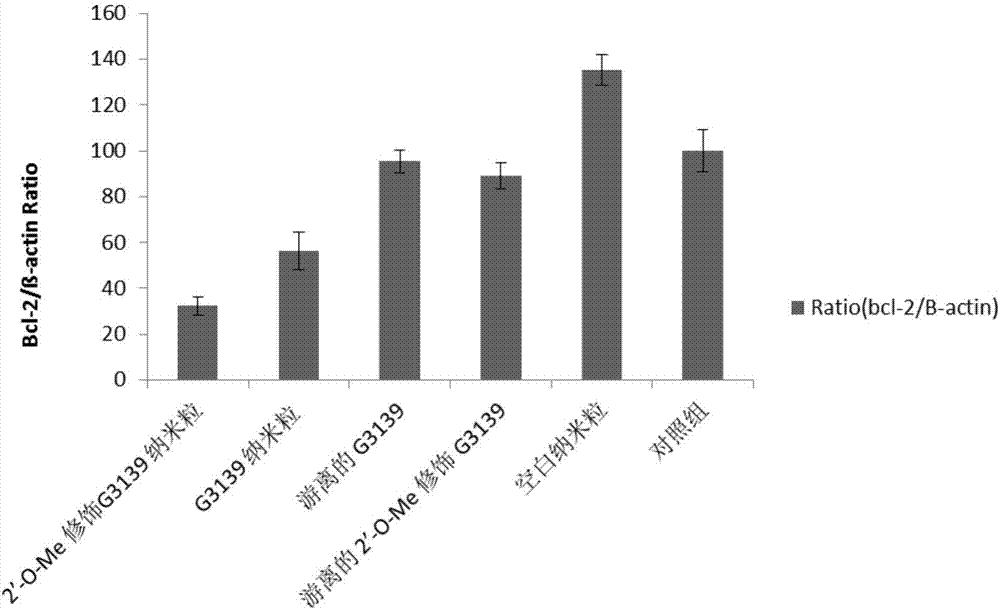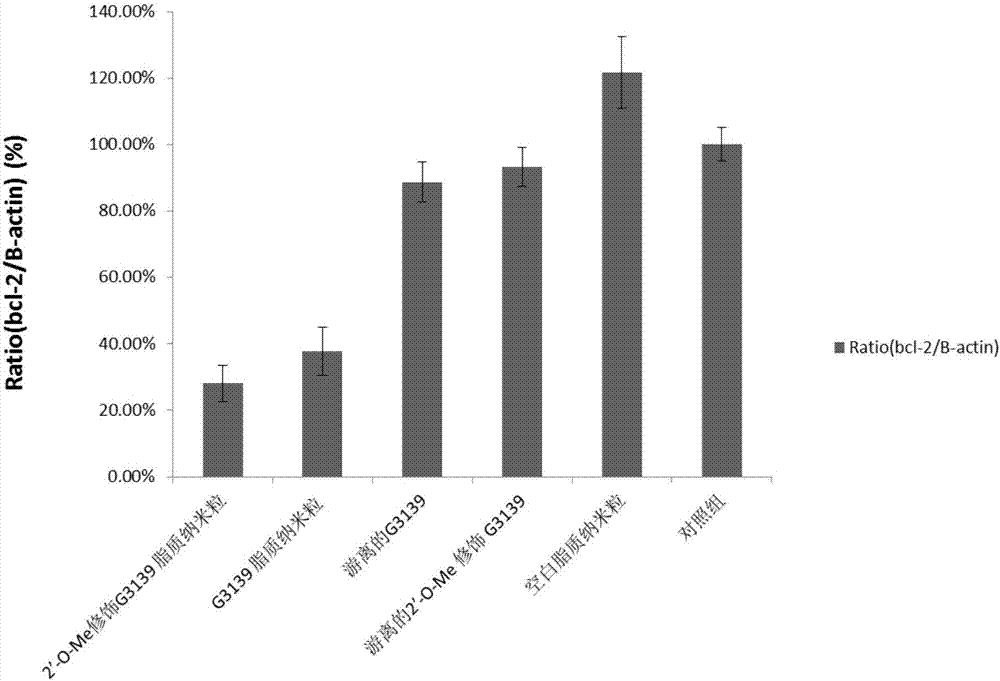Lipid nanoparticle for inhibiting antisense oligonucleotide of bcl-2 and preparation method of lipid nanoparticle
A lipid nanoparticle and bcl-2 technology, applied in the biological field, can solve problems such as easy degradation, reduced stability, weak binding, etc., and achieve the effects of high cell acceptance, improved stability, and accelerated release
- Summary
- Abstract
- Description
- Claims
- Application Information
AI Technical Summary
Problems solved by technology
Method used
Image
Examples
Embodiment 1
[0083] A preparation method of lipid nanoparticles inhibiting bcl-2 antisense oligonucleotides, the specific steps are as follows:
[0084] (1) Dissolve DOTAP, Egg PC, cholesterol, Tween 80, and TPGS at a molar ratio of 25:45:20:5:5 in 80% ethanol to obtain a mixed ethanol solution; the antisense oligonucleotide 5'- The whole chain of TCT CCC AGC GTG CGC CAT-3' is phosphorothioated and dissolved in PBS buffer (1X pH=7) to obtain an antisense oligonucleotide solution;
[0085] (2) Mix the obtained mixed ethanol solution and the antisense oligonucleotide solution in equal volumes to obtain a mixed solution with a final ethanol concentration of 40%;
[0086] (3) The 40% final ethanol concentration mixed solution obtained in step (2) is further diluted with equal volume of PBS solution; the final ethanol concentration mixed solution is diluted with PBS solution (1X pH=7.4) isometrically diluted until the final ethanol concentration is obtained. Preparation mixtures with a concent...
Embodiment 2
[0091] A preparation method of lipid nanoparticles inhibiting bcl-2 antisense oligonucleotides, the specific steps are as follows:
[0092] (1) Dissolve DOTMA, DOPC, cholesterol, Tween 40, mPEG550-DPPE with a molar ratio of 35:40:15:1:1 in 80% ethanol to obtain a mixed ethanol solution; the antisense oligonucleotide 5' UCU CCC AGC GTG CGC CAU 3' full chain is phosphorothioated, both ends are modified by 2'-O-Me, dissolved in PBS buffer (1X pH=7) to obtain antisense oligonucleotide solution;
[0093] (2) Mix the obtained mixed ethanol solution and the antisense oligonucleotide solution in equal volumes to obtain a mixed solution with a final ethanol concentration of 40%;
[0094] (3) The 40% final ethanol concentration mixed solution obtained in step (2) is further diluted with equal volume of PBS solution; the final ethanol concentration mixed solution is diluted with PBS solution (1X pH=7.4) isometrically diluted until the final ethanol concentration is obtained. Preparation...
Embodiment 3
[0099] A preparation method of lipid nanoparticles inhibiting bcl-2 antisense oligonucleotides, the specific steps are as follows:
[0100] (1) Dissolve DDAB, DSPC, cholesterol, Tween 60, and mPEG3000-DPPE with a molar ratio of 30:50:25:3:3 in 80% ethanol to obtain a mixed ethanol solution; the antisense oligonucleotide 5' UCU CCC AGC GTG CGC CAU 3' full chain is phosphorothioated, both ends are modified by 2'-O-Me and dissolved in PBS buffer (1X pH=7) to obtain antisense oligonucleotide solution;
[0101] (2) Mix the obtained mixed ethanol solution and the antisense oligonucleotide solution in equal volumes to obtain a mixed solution with a final ethanol concentration of 40%;
[0102] (3) The 40% final ethanol concentration mixed solution obtained in step (2) is further diluted with equal volume of PBS solution; the final ethanol concentration mixed solution is diluted with PBS solution (1X pH=7.4) isometrically diluted until the final ethanol concentration is obtained. Prep...
PUM
| Property | Measurement | Unit |
|---|---|---|
| molecular weight | aaaaa | aaaaa |
| particle diameter | aaaaa | aaaaa |
| particle diameter | aaaaa | aaaaa |
Abstract
Description
Claims
Application Information
 Login to View More
Login to View More - R&D
- Intellectual Property
- Life Sciences
- Materials
- Tech Scout
- Unparalleled Data Quality
- Higher Quality Content
- 60% Fewer Hallucinations
Browse by: Latest US Patents, China's latest patents, Technical Efficacy Thesaurus, Application Domain, Technology Topic, Popular Technical Reports.
© 2025 PatSnap. All rights reserved.Legal|Privacy policy|Modern Slavery Act Transparency Statement|Sitemap|About US| Contact US: help@patsnap.com



